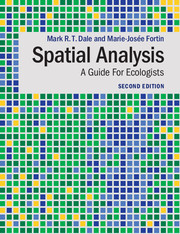Book contents
- Frontmatter
- Dedication
- Contents
- Preface
- 1 Spatial concepts and notions
- 2 Ecological and spatial processes
- 3 Points, lines and graphs
- 4 Spatial analysis of complete point location data
- 5 Contiguous units analysis
- 6 Spatial analysis of sample data
- 7 Spatial relationship and multiscale analysis
- 8 Spatial autocorrelation and inferential tests
- 9 Spatial partitioning: spatial clusters and boundary detection
- 10 Spatial diversity analysis
- 11 Spatio-temporal analysis
- 12 Closing comments and future directions
- References
- Index
3 - Points, lines and graphs
Published online by Cambridge University Press: 05 September 2014
- Frontmatter
- Dedication
- Contents
- Preface
- 1 Spatial concepts and notions
- 2 Ecological and spatial processes
- 3 Points, lines and graphs
- 4 Spatial analysis of complete point location data
- 5 Contiguous units analysis
- 6 Spatial analysis of sample data
- 7 Spatial relationship and multiscale analysis
- 8 Spatial autocorrelation and inferential tests
- 9 Spatial partitioning: spatial clusters and boundary detection
- 10 Spatial diversity analysis
- 11 Spatio-temporal analysis
- 12 Closing comments and future directions
- References
- Index
Summary
Introduction
In ecological studies, we often wish to perform analyses of the spatial characteristics of objects or structural units by reducing their natural complexity, where practical, representing them with simplified forms such as dimensionless points, one-dimensional lines, whether curving or straight, or simple polygons. Obvious examples would be tree stems in a forest represented by points in a two-dimensional plane, or aquatic stream systems in a landscape, represented by branching linear structures. These points and lines can be studied in separate analyses, or they may be considered together, as we might in a study of a clonally growing plant, using points to represent erect stems and lines to represent the rhizomes or stolons of the system. In some specialized cases, we will still use points to represent the structural units, but the lines between them will now indicate relationships, not physical elements of the system but functional or relational interactions between the structural units. The best approach to describe and analyse that kind of system is to use graph theory. Graph theory provides a body of mathematical knowledge based on simple concepts, in which structural units are represented by dimensionless points and relationships between the units are represented by lines joining the points in pairs. For clarity, we will refer to the points when they are in a graph as nodes, and the lines between them as edges (see Glossary; Figure 3.1a). In this chapter, the Glossary provides definitions of graph terminology needed to understand the key terms (in bold in the text) related to graph theory. The nodes may have additional qualitative and quantitative characteristics associated with them, like species identification or stem size, and the edges may have directions (Figure 3.1b) and signs (plus or minus) as in Figure 3.1c, or other properties such as rates of flow. The concepts of graph theory have been applied to a range of ecological phenomena including interspecific associations in communities, spatial structure and dispersal in landscapes, as well as the relationships among metapopulations and metacommunities. The open and flexible conceptual model that it provides can contribute to our understanding of the relationship between structure and processes, including the mechanisms of configuration effects and compositional differences. This chapter shows how objects, which can be represented as points or lines, can be analysed separately or together, including within the formal structure of a graph.
- Type
- Chapter
- Information
- Spatial AnalysisA Guide For Ecologists, pp. 46 - 87Publisher: Cambridge University PressPrint publication year: 2014



